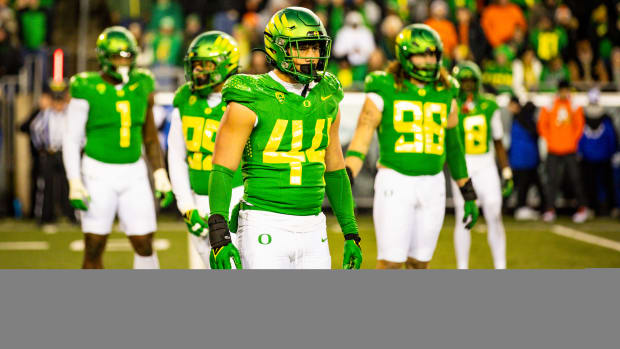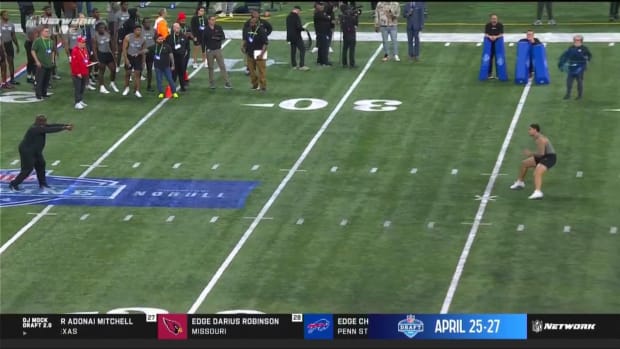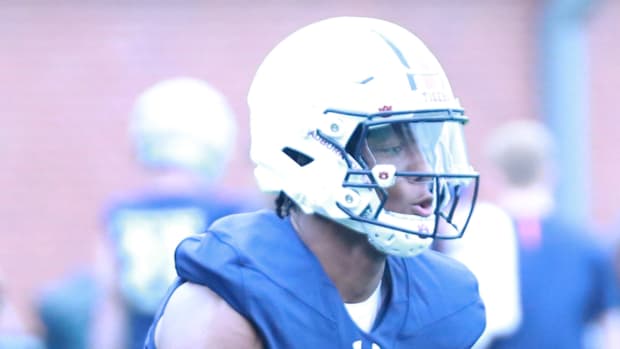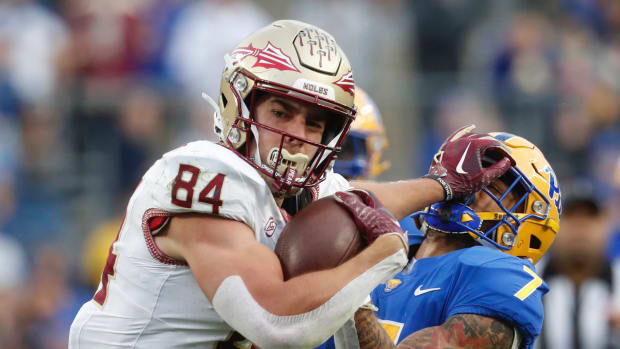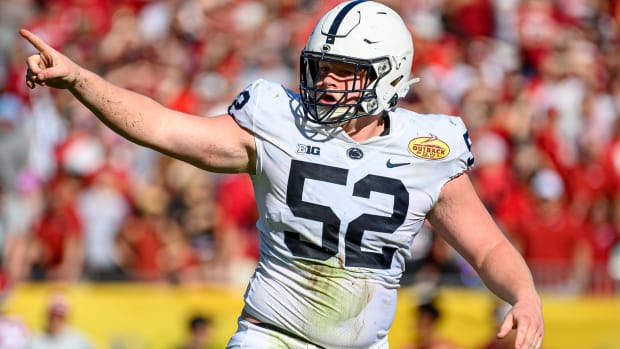After embarrassing home loss, Oregon’s flaws exposed; TCU winning despite injuries
With 10 minutes remaining at Autzen Stadium on Saturday night, Utah led Oregon 62–13. It was a surreal flipping of the script, as this time it was the Utes who were tactfully ending a blowout victory—a role that over the last decade had normally belonged to the Ducks.
Having endured its worst home defeat since 1977 Oregon now finds itself in the unfamiliar position of having lost three of its last five games. The losses—to Ohio State (in last season’s national championship game), Michigan State and Utah—aren’t as alarming as the way in which they happened. The Ducks gave up an average of 45 points and 486 yards in each of those three defeats. The loss to the Utes was the worst for Oregon since 2003, and Utah’s 62 points were the most scored against the Ducks since 1985.
“Anything that could have gone wrong,” Oregon coach Mark Helfrich said, “did go wrong.”
While it’s too early to bury the Ducks, there are some troubling signs: Their scoring defense ranks 117th in the FBS, and they have also been getting pedestrian quarterback play. Both things have coaches who have faced Oregon forecasting its slump as more of a trend than a blip.
Are the Ducks entering a downward cycle just as Texas did after reaching the BCS title game with quarterback Colt McCoy in January 2010? Or does Oregon merely need a year to recover after losing Heisman Trophy winner Marcus Mariota and two elite defensive players—lineman Arik Armstead and shutdown corner Ifo Ekpre-Olomu?
“It looked [as if] it unraveled against Utah in all phases,” said a veteran Pac-12 coach familiar with the Ducks. “There haven’t been many nights like that for Oregon in the last 15 years.”
After the loss to the Utes, the Ducks dropped out of the AP Top 25 for the first time since 2009. How quickly can they return to being nationally relevant?
The Inside Read spoke to five coaches who have played or studied Oregon recently, and their opinions varied. One coach says that there’s still a chance the Ducks can win the Pac-12 North, which is seemingly wide open. And several others also say that that No. 10 Utah, which dominated Michigan on Sept. 3, may be really good.
But many also say Oregon’s flaws this season are too glaring to overcome, and that the Ducks’ anemic defense may force Helfrich to make changes to his staff. The coaches’ criticisms of Oregon focused on two things: poor quarterback play, an overmatched defense. Both factors are feeding off each other to produce lopsided results.
Helfrich is 26–6 in his third season as coach, with half his losses coming in the last five games. The five coaches’ most direct criticism of Helfrich is that he failed to have a capable replacement for Mariota, the No. 2 pick in last April's NFL draft. Several say that Mariota was the best college quarterback they’ve ever seen.
“He covered up a lot of things,” says one assistant.
The transfer of quarterback Vernon Adams Jr. from Eastern Washington made for an intriguing off-season story, especially with the drama of whether or not he’d be eligible come August. But coaches who compete against the Ducks view it as irresponsible that an elite program would have to have to rely on an FCS transfer for its starting quarterback. “That shocked me,” says one coach.
Adams, who is playing through a broken index finger on his throwing hand, so far hasn’t proven to be the answer at quarterback. More than in any recent season at Oregon, the Ducks are going to have to win shootouts, and it’s still uncertain whether Adams is the right guy for such games.
Adams is 5' 11", with average arm strength. There’s a reason he ended up at Eastern Washington instead of, say, Washington in the first place. “Vernon Adams is just a guy,” says an assistant familiar with Oregon. “He put up numbers, but Eastern Washington is still putting up numbers without him. He wouldn’t play at Ohio State or USC. Would he play at another great school? Probably not. He took a huge jump up.”
Adams threw two interceptions in the 31–28 loss to the Spartans on Sept. 12, and was benched in the second quarter against the Utes after after he completed just two of his first seven passes. He badly underthrew a receiver on one of those throws, and Ducks coaches attributed some of his ineffectiveness to the broken finger. Several of the rival coaches also pointed out that Oregon doesn't seem to have players with the same game-breaking speed as in the past.
But the Ducks’ system is based on wearing out opponents and scoring in bunches because of their tempo and speed. That scheme isn’t nearly as novel as it once was in this era of fast-paced, scoreboard-busting offenses. Defenses now routinely face offenses that run attacks similar Oregon’s. When the offense sputters, tempo works against the Ducks and exposes the defense by forcing the unit onto the field for long stretches.
A similar pattern emerged last January in Oregon’s 42–20 loss to Ohio State. The Buckeyes closed the game with 21 unanswered points. “[The Ducks] need that offense to be elite to help their defense, which is average,” says a head coach familiar with Oregon. “Their defense isn’t very good, especially their secondary and inside linebackers. And I thought schematically they were pretty vanilla.”
The concern for the Ducks this season runs deep, as the defense was also bad against Eastern Washington (42 points) and Georgia State (28). Oregon has given up an average of 40.8 points per game. Last year, the Ducks ranked 30th in scoring defense, yielding nearly half as many points (23.6).
The good news for Oregon is that it will be a heavy favorite in its next three games—at Colorado, at home against Washington State and at Washington. The bad news is that if the Ducks lose one of those games, it will be much worse than getting blown out by a strong Utah team.
The seeds of the defense’s collapse were planted last season. In January 2014, Oregon promoted assistant coach Don Pellum to replace longtime defensive coordinator Nick Aliotti, who retired after the ’13 season. Pellum’s defense got undressed in a stunning 31–24 loss to Arizona last October, which prompted this quote to The Inside Read:
“Their defensive scheme is really unsound,” said an assistant coach whose team faced the Ducks. “They got away with it in the past because they were always so far ahead on the scoreboard, but I’ve always said, ‘Put them in a tight game [and] they’re not going to be able to hold up defensively.’ ”
To Pellum’s credit, Oregon rebounded with a much stronger performance against Arizona in the Pac-12 title game, winning 51–13. But without Mariota to control the tempo, coaches are skeptical of how competitive the Ducks can be. Oregon’s secondary is easy to exploit because of its inexperience. Against the Utes, the Ducks started two freshman cornerbacks and no juniors or seniors in the secondary.
Oregon ranks 114th in pass defense, and the Ducks spent much of Saturday testing different secondary lineups with little success. Their linebackers are average, and the defense's only star, 6' 7" end DeForest Buckner, is easy to double-team because of the lack of playmakers elsewhere.
“They’re not very good in the secondary,” a Pac-12 assistant says. “They’ve had to try to help out in the secondary by playing more two-man or two- and four-drop than they probably want to. The amount of two-man they’ve played is ridiculous. If you’re able to keep them in two-man or two-high situations, you’ll be able to run a little bit and still be able to take advantage of some of their cornerbacks.”
Translated loosely, that means that Oregon’s run defense suffers because the pass defense needs so much help. Around the Pac-12, it's easy to see the SOS—Oregon is on the ropes and no one is sure if the Ducks have the personnel to turn things around.
Tony Gutierrez/AP
Injuries hurting TCU, but Horned Frogs keep winning
As dramatic as TCU’s 55–52 victory at Texas Tech was on Saturday night, Horned Frogs coach Gary Patterson’s most heart-pounding moment came after the game—as it has all season. That was when his swamped medical staff revealed the extent of the latest injuries to his beleaguered fourth-ranked team. Following the wild triumph over the Red Raiders, Patterson found out that starting junior wide receiver Ty Slanina was likely out for the season, and that sophomore wide receiver Emanuel Porter would also miss a few weeks.
Entering the weekend, Patterson had already lost seven defensive starters, mainly because of injuries. He was also without speedy starting wideout Kolby Listenbee (hip) on Saturday. “I’ve never been through anything like this,” Patterson says. “But nobody’s worried about it.”
Patterson, however, had endured plenty of angst in Saturday’s win. When TCU quarterback Trevone Boykin’s pass on fourth-and-goal from the Texas Tech four-yard line bounced off the hand of wide receiver Josh Doctson in the end zone, the coach had one thought: “We lost a close ballgame,” Patterson says, “but our kids fought their tails off.”
Of course, Boykin’s pass ricocheted into the hands of running back Aaron Green in the back of the end zone for the game-winning score with 23 seconds left. The Horned Frogs then nearly gave the game away on the final play by allowing a lateral-filled 40-yard gain that they finally stopped at their 10-yard line.
“One of the craziest plays of all time was covered up by the tipped catch,’ says Patterson with a laugh.
Doctson’s assist on the game-winning pass was only part of an astounding performance on Saturday. He tied a Big 12 single-game record with 18 catches for 267 yards and three touchdowns, all career highs. “To win a game like that, somebody was going to have to step up and have that kind of [performance],” Patterson says.
Saturday’s victory was the first game of what Patterson says is his team's toughest four-game stretch this season. TCU hosts Texas next Saturday before playing back-to-back road games against Kansas State and Iowa State. After that comes what will be a much-needed off week.
Patterson considers each of the stretch’s three road games tough environments to play in, and believes that the Longhorns’ athleticism will pose problems.
“We don’t have time to feel sorry for ourselves,” he says. “Forever I won ballgames 17–10 and they said, Well, your offense isn't good. Now, we win 55–52 and [it’s], What do you think about your defense? I didn’t want to talk about our offense back then. They were doing the best they [could], just like these guys are defensively."
The defensive-minded Patterson knows his patchwork unit must make more stops in the offense-crazy Big 12 for his team to have a shot at the College Football Playoff. While his inexperienced D made plenty of mistakes on Saturday, he says that, at times, he thrust some players into action in bad situations.
But Patterson also says that he is encouraged despite the fact that his defense gave up 607 yards to Texas Tech, the second straight game that the Horned Frogs have allowed over 500 yards, and the second-most they have surrendered in the last 10 years. TCU ranks 81st in the FBS in total defense (405.8 yards per game) after being 18th a year ago (341.8). “The best thing that we’re doing is we’re playing really hard,” Patterson says.
The Horned Frogs’ dramatic victory on Saturday had special significance for their defensive newcomers. “There’s been a lot of guys we’ve had here that have been in the wars defensively that trust us,” Patterson says. “These young guys, they don’t know the history. I talked to some of them on the way home and I think there was some valuable lessons learned.”
This week, Patterson hopes to get back senior defensive end Terrell Lathan, who missed Saturday’s game with a shoulder injury. The 6' 5", 280-pound senior was third on the team in sacks last season with 5½ .
Yet as challenging as all of the injuries have been, Patterson knows there is a silver lining. When TCU went 4–8 in 2013 and missed a bowl game for just the second time in his 15 seasons as coach, injuries were also problematic.
One of the biggest problems that year was an injury to starting quarterback Casey Pachall, which prompted the emergence of Boykin, who is now a Heisman Trophy contender. “Our negative right now,” Patterson says, “[will be] our positive later on.”
Patterson is just hoping that the positives continue during and after games.
For a daily dose of college football insight, check out The Inside Read every weekday on Campus Rush.


